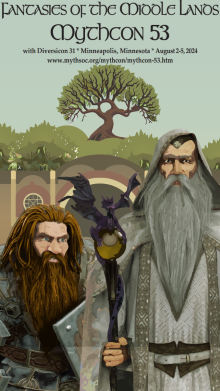Loading...
Location
Minneapolis, Minnesota
Document Type
Presentation
Event Website
https://www.mythsoc.org/mythcon/mythcon-53.htm
Start Date
3-8-2024 3:30 PM
End Date
3-8-2024 4:20 PM
Description
Although Tolkien’s biographer Humphrey Carpenter downplayed Tolkien’s interest in drama, a closer look at “On Fairy-stories” and at the manuscript drafts of the historical drama, “The Homecoming of Beorhtnoth” suggests that this verse play should be more widely recognized as a drama with the potential for stage production. The recent edition by Peter Grybauskas, which includes one of the earlier drafts of the play and Tolkien’s own recording of the drama, gives readers some new insight into the play’s development and suitability for performance. A closer examination of further manuscript drafts, particularly a recently acquired version now in the Brotherton Library at the University of Leeds, highlights Tolkien’s stage directions in a play suitable for a theatrical production. In addition to the primary world drama in this text, however, there is a further development into a liminal realm between primary and secondary worlds when one of the characters enters into what I would argue is a faërian drama. Using Janet Brennan Croft’s outline of the features of faërian dramas, I propose to examine the dream vision near the end of the play and the way that it transports the dreamer into the past and forward to the future. And while most critics conclude their discussions when the two characters leave the stage, the play doesn’t end there. Following Richard West’s lead, I will look at the verses in the manuscript drafts that conclude the play, which, I contend, extend the faërian dramatic experience to the audience.
Creative Commons License

This work is licensed under a Creative Commons Attribution-NonCommercial-No Derivative Works 4.0 International License.
Included in
Tolkien’s "The Homecoming of Beorhtnoth": Manuscript Revisions and Faërian Dramas
Minneapolis, Minnesota
Although Tolkien’s biographer Humphrey Carpenter downplayed Tolkien’s interest in drama, a closer look at “On Fairy-stories” and at the manuscript drafts of the historical drama, “The Homecoming of Beorhtnoth” suggests that this verse play should be more widely recognized as a drama with the potential for stage production. The recent edition by Peter Grybauskas, which includes one of the earlier drafts of the play and Tolkien’s own recording of the drama, gives readers some new insight into the play’s development and suitability for performance. A closer examination of further manuscript drafts, particularly a recently acquired version now in the Brotherton Library at the University of Leeds, highlights Tolkien’s stage directions in a play suitable for a theatrical production. In addition to the primary world drama in this text, however, there is a further development into a liminal realm between primary and secondary worlds when one of the characters enters into what I would argue is a faërian drama. Using Janet Brennan Croft’s outline of the features of faërian dramas, I propose to examine the dream vision near the end of the play and the way that it transports the dreamer into the past and forward to the future. And while most critics conclude their discussions when the two characters leave the stage, the play doesn’t end there. Following Richard West’s lead, I will look at the verses in the manuscript drafts that conclude the play, which, I contend, extend the faërian dramatic experience to the audience.
https://dc.swosu.edu/mythcon/mc53/schedule/27


